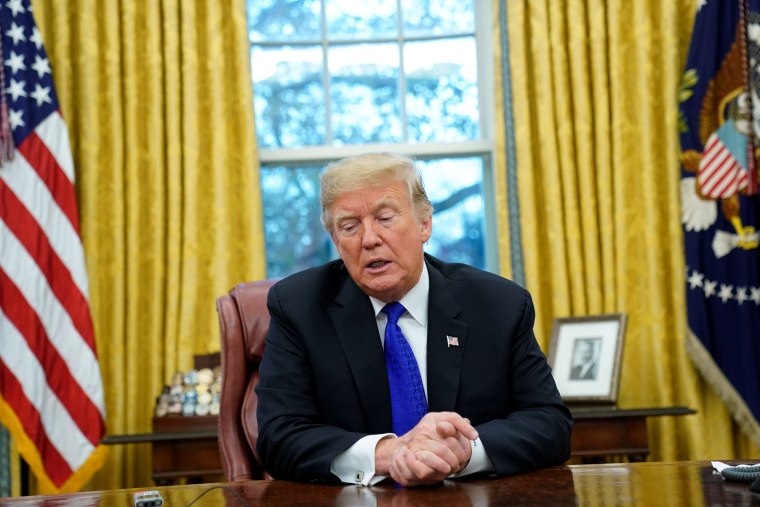In recent court filings and in open court, President Donald Trump has been identified as “Individual-1” in a federal criminal probe. Based on court documents, it also seems reasonably clear that the president — by whatever name you call him — is deeply (and perhaps criminally) implicated in federal election law crimes committed by his former personal attorney, Michael Cohen. As a recent filing by Manhattan federal prosecutors notes, “Individual-1” (the president) directed Cohen to make payments to two women to conceal his sexual relationship with them. Cohen admitted that this conduct was a crime — indeed, Cohen pled guilty to it in a Manhattan federal courtroom and was sentenced Wednesday to three years in prison.
Why didn’t prosecutors simply name the president as the man who directed Cohen to make those payments? The use of “Individual-1” seems like a bulky and unnecessary contrivance. The U.S. Attorneys' Manual (a guidebook for federal prosecutors) supplies an answer:
"Ordinarily, there is no need to name a person as an unindicted co-conspirator in an indictment [or other court document] in order to fulfill any legitimate prosecutorial interest or duty…. In any indictment where an allegation that the defendant conspired with 'another person or persons known' is insufficient, some other generic reference should be used, such as 'Employee 1' or 'Company 2.'”
So, prosecutors adhered to the rules when they referred to the president as “Individual-1.” What’s the rationale behind this? Again, the guidebook is helpful:
“In all public filings and proceedings, federal prosecutors should remain sensitive to the privacy and reputation interests of uncharged third-parties.... [T]his means that, in the absence of some significant justification, it is not appropriate to identify … a third-party wrongdoer unless that party has been officially charged with the misconduct at issue…. [T]here is ordinarily 'no legitimate governmental interest served' by the government's public allegation of wrongdoing by an uncharged party…."
SIGN UP FOR THE THINK WEEKLY NEWSLETTER HERE
When an individual is named and charged in a grand jury indictment, the reputational harm is substantial. But at least a named defendant has the right, enshrined by the Constitution, to challenge that indictment at trial in open court. A named but unindicted co-conspirator has no such opportunity, as the guidebook acknowledges, and prosecutors must therefore be sensitive to any reputational harm. In other words, prosecutors in the Cohen case are not providing Trump with an extra level of anonymity but are instead simply following established rules.
Prosecutors in the Cohen case are not providing Trump with an extra level of anonymity but are instead simply following established rules.
That gives rise to a third question, based on the guidebook’s acknowledgment that there might be some “significant justification” to depart from the normal rule and to actually name an unindicted coconspirator. When does this exception apply and when would this “significant justification” threshold be reached? The answer, again, is a matter of law — the law of evidence.
Bear with me. This gets a bit complicated but it is interesting. The Federal Rules of Evidence hold that hearsay — an out-of-court statement offered in court for its truth — is inadmissible. Many people have at least heard of that rule, even if they do not quite know how it works. Good prosecutors, of course, know the hearsay rule intimately and also know that there are numerous exceptions to it. One of the most important exceptions is another rule that permits statements by co-conspirators, even if otherwise hearsay, to be admitted at trial.
Here’s a hypothetical example to explain both the hearsay rule and the co-conspirator exception to it. Let’s say Joe is on trial for fraud. Jane, the honest bookkeeper who worked for him, is called by the government as a witness at trial. Jane overheard a conversation between Joe and Bill, (since deceased) at the office, in which Bill urged Joe to backdate numerous invoices. The government wants Jane to repeat Bill’s statement (“backdate those invoices, Joe”) at Joe’s trial, but it is clearly hearsay. Why? Because the statement made by Bill to Joe out of court is being offered in court, by the government through Jane, for its truth.
The statement can be admitted, however, if two things are true. First, based on evidence supplied by the government (and evaluated by a judge), Bill can be determined to be an unindicted co-conspirator. And second, if Bill’s out-of-court statement was made during the conspiracy and in furtherance of it, it can be admitted at trial, through Jane and against Joe. That’s the classic formulation for the admission into evidence of a statement by a co-conspirator.
The government, therefore, has a legitimate and significant justification in certain instances to identify an unindicted co-conspirator by name — it is foundational to an important hearsay exception and necessary to the admission of evidence at trial. And, even if the government chooses — as the guidebook counsels — not to name those unindicted co-conspirators in publicly filed court documents, there are other, more discreet, ways to do it (not necessary to the discussion here). This helps defense counsel and the judge understand the theory of the government’s case so they can be prepared to oppose it and rule on it, respectively.
The federal prosecutors in the Cohen case followed the guidelines. But they also know that one of the rules out there — the one that allows the statements of co-conspirators, including those that are not indicted, to be admitted in court and at trial — may eventually require them to name other members of the conspiracy. What you see here are smart prosecutors doing it right.

